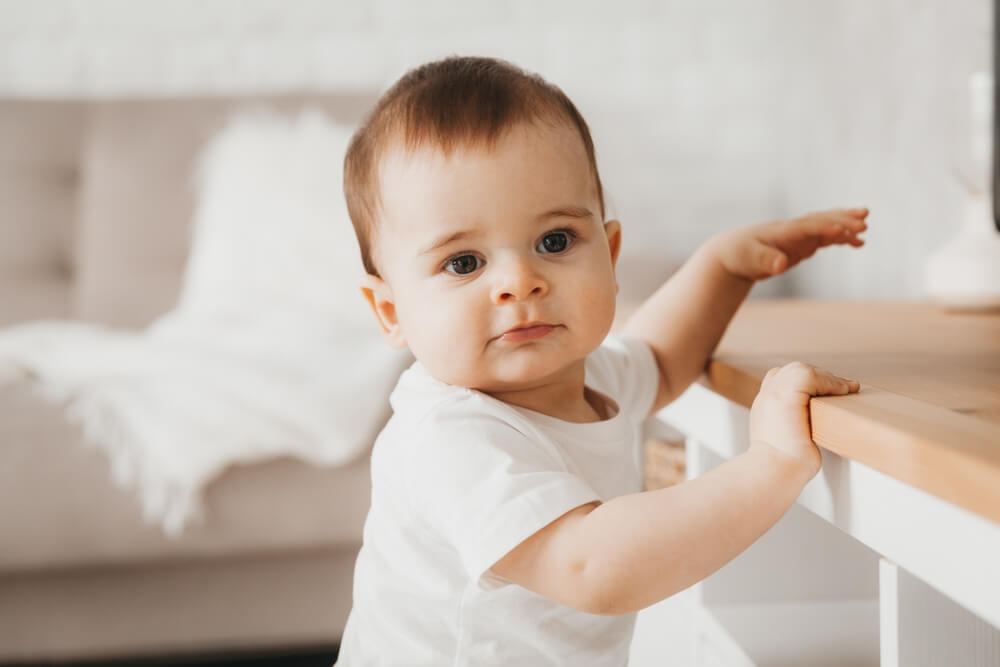What Age Do Babies Crawl? Key Insights for Parents

When do babies start crawling? It’s one of those commonly asked questions on the mind of many moms and dads as they watch their little ones grow and develop, eagerly awaiting the next big milestone.
In this guide, we’ll explore the average age range when you can expect to see your baby crawling.
Contents:
- When Should I Expect My Baby to Crawl?
- Tips and Tricks To Encourage Your Baby To Crawl
- Is Your Baby Crawling Normally?
- Keep Your Crawler Safe
- What if Your Baby Isn’t Crawling Yet?
- Watch for the Next Developmental Milestones
- FAQs
When Should I Expect My Baby to Crawl?
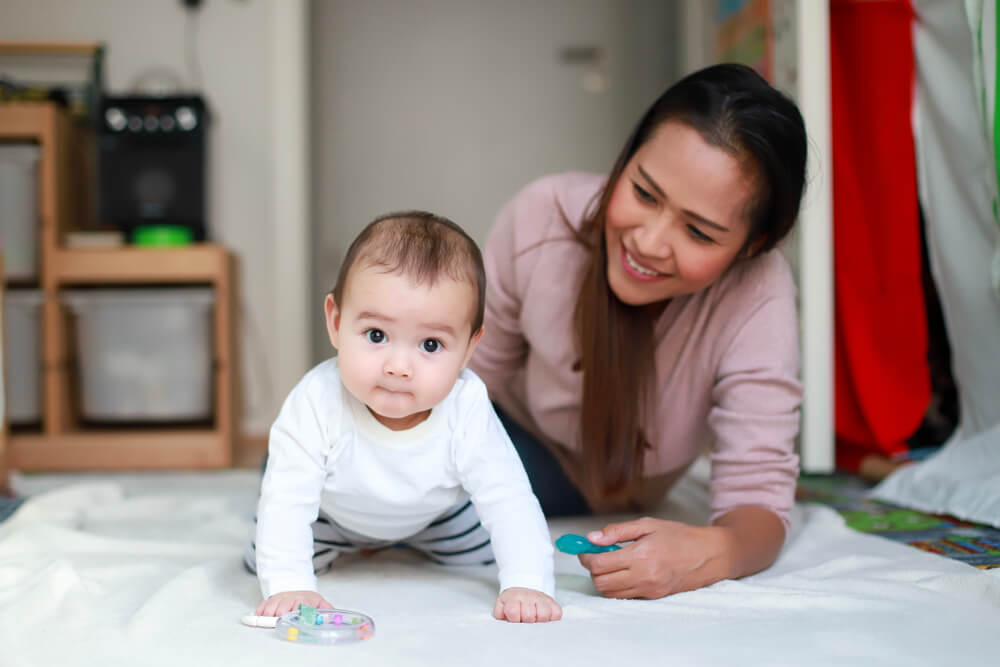
Onjira Leibe/Shutterstock.com
First, let’s focus on the titular question: “When do babies start crawling?” There’s no fixed or definitive age when a baby must be crawling by, but in general, a lot of babies will crawl between the ages of six months and one year. To narrow it down even further, most babies tend to start crawling at around nine months of age, on average.
Signs Your Baby Is Ready To Crawl
Parents can often tell when their baby might be building up to crawling by looking for the following key signs:
- They roll over from side to side while lying down
- They lie on their belly and lift their head
- They try to do push-up-style movements during tummy time
- They can sit without much support
- They look around the room a lot during tummy time
- They get on all fours and rock back and forth
Crawling Stages
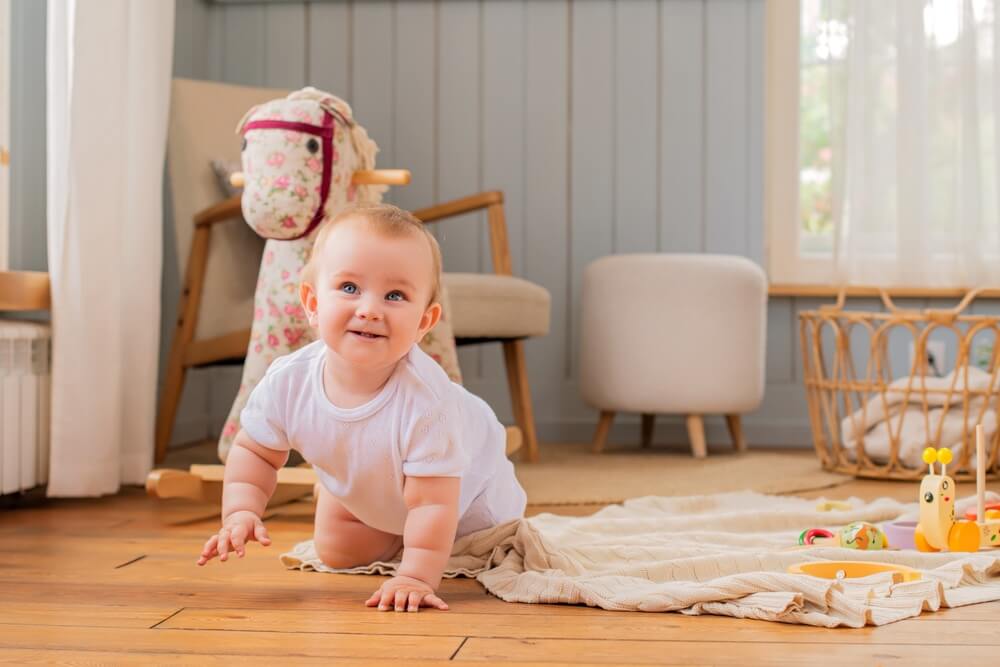
Maria Moroz/Shutterstock.com
Some experts divide the crawling process into multiple smaller stages or milestones for parents to look and aim for. These stages include:
- Tummy time: This is when a baby lies on their tummy to start building the muscles needed for crawling. It’s strongly recommended to aim for half an hour of tummy time a day for infants, possibly broken up into five-minute chunks throughout the day.
- Pivoting: This is when a baby is lying on its tummy and slowly starts to rotate around in circles.
- Planking: This is when babies lift into a plank pose, supporting themselves on their hands and knees or toes, like they’re about to do a push-up.
- Rocking: Many babies will next progress to a rocking stage, where they get on all fours and then rock back and forth.
Crawling Styles
There are various ways babies might try to crawl:
- Classic: The classic method is the one you most likely imagine when you think of a baby crawling along on their hands and knees.
- Commando: In the commando crawl, the baby’s tummy and legs stay flat and they use their arms to pull themselves along.
- Scoot: The scoot involves the baby getting into a sitting position and then using their legs to pull them along.
- Crab Crawl: Baby moves sideways, often pushing off with one hand and leg.
- Bear Crawl: Baby keeps arms and legs straight, moving on hands and feet.
All these styles are normal, and as long as your baby is making efforts to move, they are developing their muscles and coordination.
Crawling and Sleep

DinaPhoto/Shutterstock.com
Crawling often tends to coincide with sleep challenges for families to overcome. This is because, when your baby starts crawling, they might become more active in the end, crawling around or lifting themselves up in their crib, which can mean it takes longer for them to get to sleep. Some babies go through a stage of sleep regression at this time, but it should resolve itself quite quickly.
Is Crawling a Developmental Milestone?
The CDC does not classify crawling as a developmental milestone, so it is not featured on official milestone lists. This is because some babies actually skip crawling altogether, and the ages at which babies crawl can vary quite a lot. However, it can still feel like a “milestone” to you and your little one, even if it’s not official.
Tips and Tricks To Encourage Your Baby To Crawl
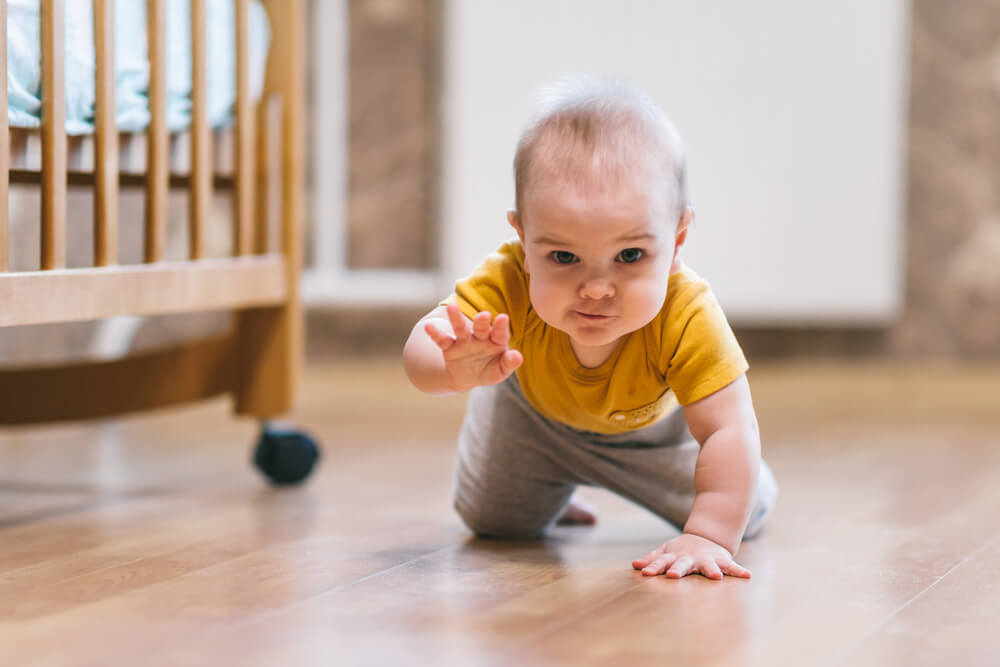
tartanparty/Shutterstock.com
There’s no need to force the process of crawling, but you can take a few measures to possibly speed things along and help your baby’s physical development. This includes:
- Put Toys High Up: Get one of your baby’s favorite toys and put it somewhere above the ground, like on top of a toy box or a chair. This will encourage your little one to lift their head and push themselves up, strengthening key muscles.
- Tummy Time: Have lots of safe, supervised tummy time with your little one so that they can get used to the feeling of being on their front and build up the strength they need in their arms and legs to lift themselves to crawl.
- Try Push-Ups: Try getting down on the ground beside or in front of your baby, and show them how to do a push-up. They may be fascinated by the whole display and eventually try to imitate you.
- Put a Toy Far Away: Grab one of your baby’s favorite toys and place it just out of reach. Then, show them how you can crawl to and from the toy to grab it. Again, with time and patience, they may eventually copy your movements and crawl themselves.
- Create a Safe and Engaging Space: Set up a designated area with a soft mat and various stimulating objects. This will encourage exploration and movement. Make sure the environment is safe, with no sharp edges or small objects that could be a choking hazard.
- Use Mirrors: Babies are often fascinated by their own reflections. Placing a mirror at their level can motivate them to move closer and interact with their reflection, promoting crawling movements.
- Dress Appropriately: Ensure your baby is dressed in comfortable clothing that allows free movement. Clothes that are too tight or have rough seams can restrict movement and discourage crawling attempts.
- Interactive Play: Engage in interactive play that involves moving toys back and forth, making your baby track the movement. This activity not only keeps them entertained but also enhances their coordination and desire to move.
Is Your Baby Crawling Normally?
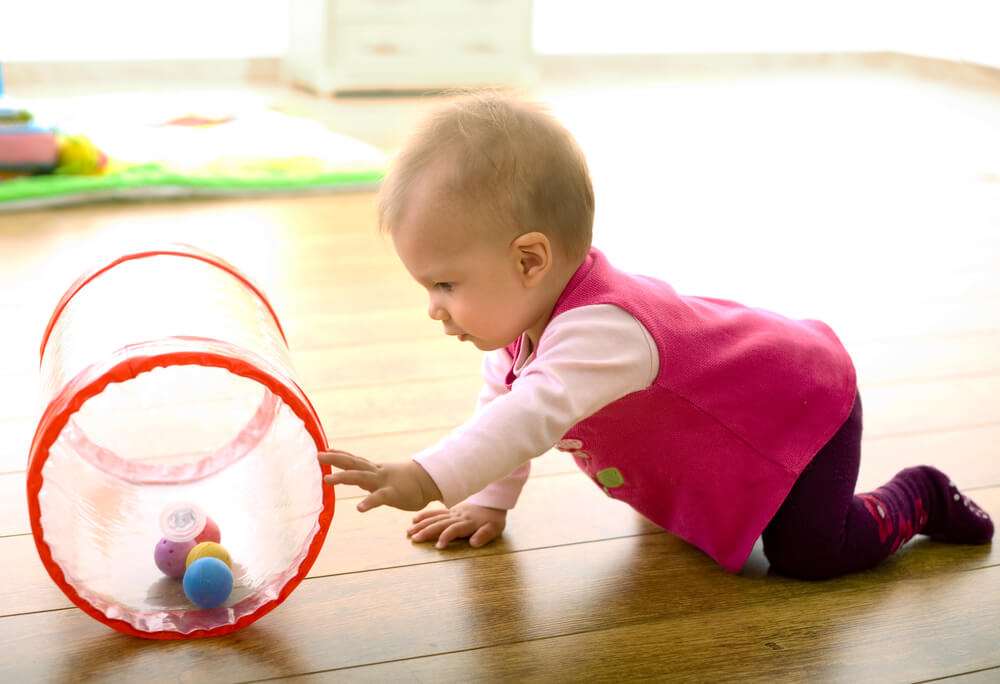
StockLite/Shutterstock.com
Once your baby starts crawling, you might wonder or worry about whether or not their way of doing it is “normal.” This is an especially common concern among first-time moms and dads who maybe have an idea in mind of how babies should crawl and might be surprised if their little one does it differently.
The truth of the matter is that babies have multiple crawling styles. They don’t all follow the usual method of just shuffling along on their hands and knees. Some babies do a kind of “commando crawl” instead, where they shuffle along on the belly, or even slide along on their bottom. Some crawl backwards, too.
All of this is normal and nothing to worry about. There are even babies who crawl with one leg bent and the other one straight out to the side. Again, it’s normal and more common than you might think, so try not to worry if your little one crawls a little differently from other babies you’ve seen in the past.
Keep Your Crawler Safe
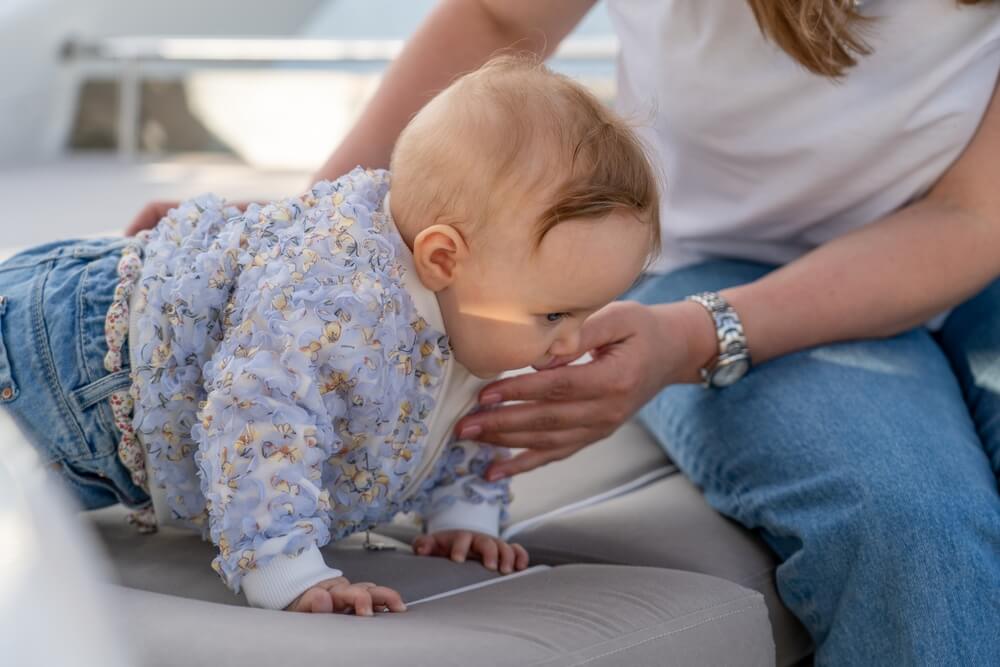
sommthink/Shutterstock.com
Once your baby starts crawling, your responsibilities as a parent will multiply! Since they’re able to get around and access so many more things, you have to supervise them even more closely and watch out for any possible hazards or risks they could encounter, such as power outlets, wires, sharp items, and loose furniture that could topple over, for example.
A good way to safeguard your child is to actually get down in a crawling position yourself and roam around to see what your baby could access and interact with. Then, you can take appropriate measures, like installing outlet covers or stair gates, to keep your little one safe. Remember, too, to keep a close eye on a crawling baby at all times.
Babyproofing Your Home
Babyproofing is crucial once your baby starts crawling. Here are some key areas to focus on:
- Cover Electrical Outlets: Use outlet covers to prevent little fingers from poking into electrical sockets.
- Secure Furniture: Ensure that heavy furniture, such as bookshelves and dressers, are anchored to the wall to prevent them from tipping over.
- Block Stairs: Install safety gates at the top and bottom of stairs to prevent falls.
- Lock Cabinets: Use childproof locks on cabinets and drawers, especially those containing hazardous materials like cleaning supplies and medications.
- Remove Small Objects: Keep small items that could be a choking hazard out of reach.
Related: 15+ Best Babyproofing Products: Parents Tested Safety Kit 2024.
Creating a Safe Crawling Space
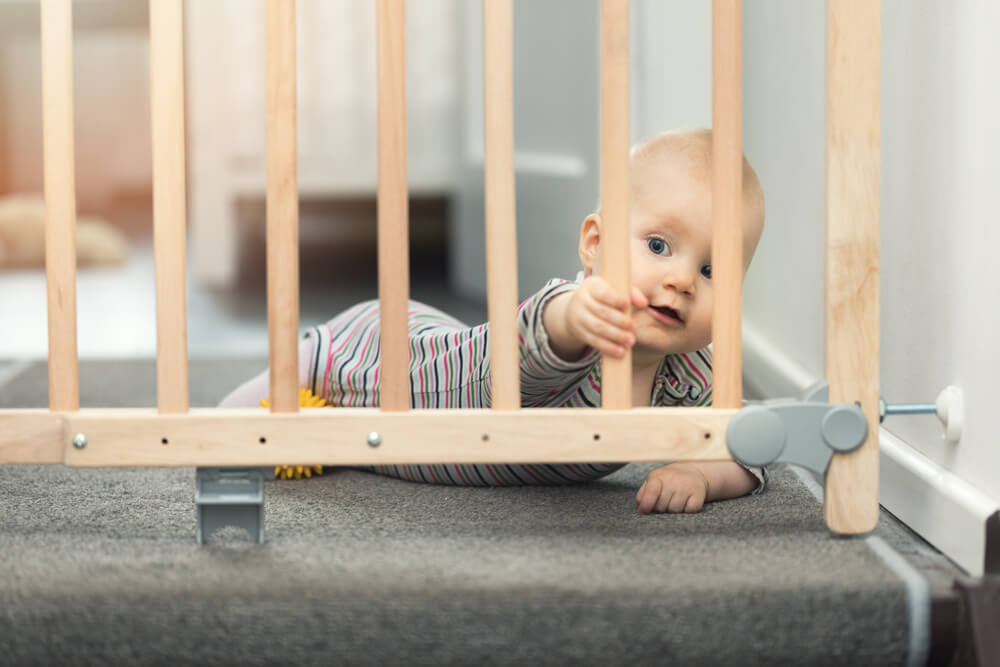
ronstik/Shutterstock.com
Designating a safe space for your baby to crawl and play can help minimize risks:
- Soft Flooring: Use a soft mat or carpet to cushion any falls and protect their knees.
- Safe Toys: Provide age-appropriate toys that encourage movement and exploration.
- Supervision: Always keep an eye on your baby while they are exploring. Stay close enough to intervene if necessary but allow them the freedom to move and discover.
Monitoring Your Baby’s Health
Regularly check your baby for signs of discomfort or injury:
- Skin Checks: Look for any redness or irritation on their knees and hands.
- Hydration: Ensure your baby stays hydrated, especially if they are crawling a lot and exerting energy.
- Rest: Allow plenty of rest periods to avoid overexertion.
And Don’t Forget…
Safety extends beyond physical protection. Keep an eye on your child’s emotional and psychological well-being as they explore their environment. Always provide encouragement, comfort, and assurance to support their confidence and curiosity.
Prepare for the Future with Findmykids
As your baby grows and starts exploring the world, ensuring their safety becomes increasingly important. The Findmykids app is an essential tool for parents, providing peace of mind by helping you keep track of your child’s location. Get familiar with it now to be prepared for when your little one becomes more mobile and adventurous.
Ensure your child’s safety with the Findmykids app, a must-have for every parent. Download it today to stay connected and keep track of your child’s location effortlessly.
What if Your Baby Isn’t Crawling Yet?
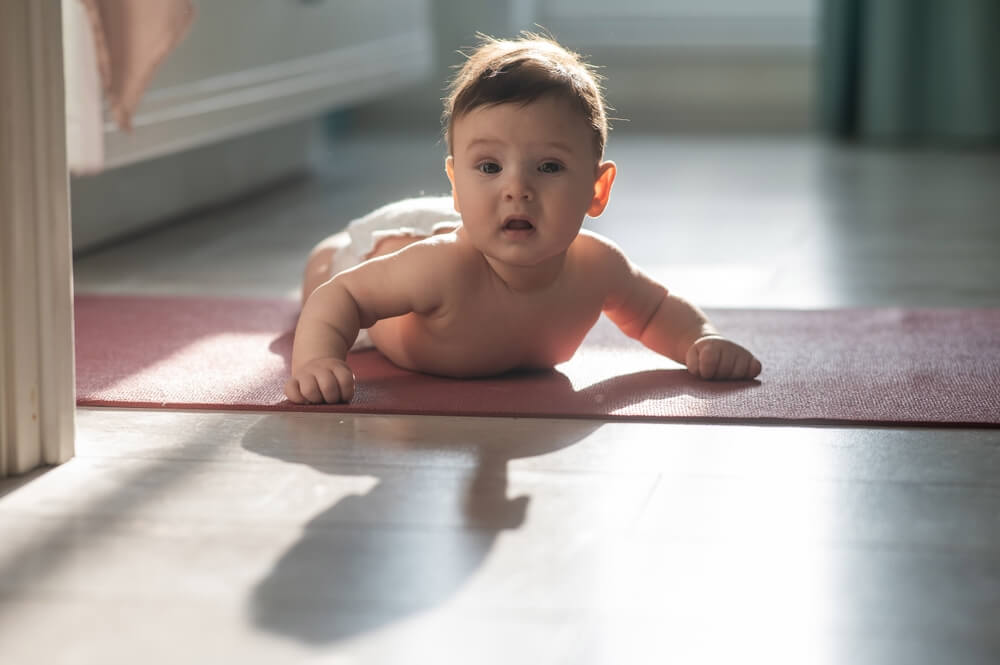
Reshetnikov_art/Shutterstock.com
If your little one is reaching the crawling age or even passing that age and still not crawling, don’t panic. There’s usually no need for any concern or fear if a child doesn’t crawl at the typical age. As long as they’re showing signs of physical development, like being able to roll over, sit up, pull themselves to stand, and lift their head, there’s nothing to fear about a lack of crawling.
As discussed throughout this guide, some children develop the crawling skill a little later than others and may not crawl until they’re 12 months or even older than that. Some also never really crawl and progress on to walk just fine. So, more often than not, you don’t have to worry or do anything at all.
Why Your Baby Isn’t Crawling Yet?
- Developmental Variations: Babies hit milestones at different times; some may crawl later or skip it altogether.
- Physical Readiness: Crawling requires strong neck, shoulder, arm, and core muscles, which develop over time.
- Interest and Motivation: Babies focused on other activities might not be interested in crawling yet.
- Environment and Space: Limited space or time in playpens can reduce opportunities for crawling practice.
- Temperament and Personality: Cautious or observant babies might take longer to start crawling.
- Health and Physical Conditions: Medical issues like low muscle tone can delay crawling. Consult a pediatrician if concerned.
When To Call the Doctor
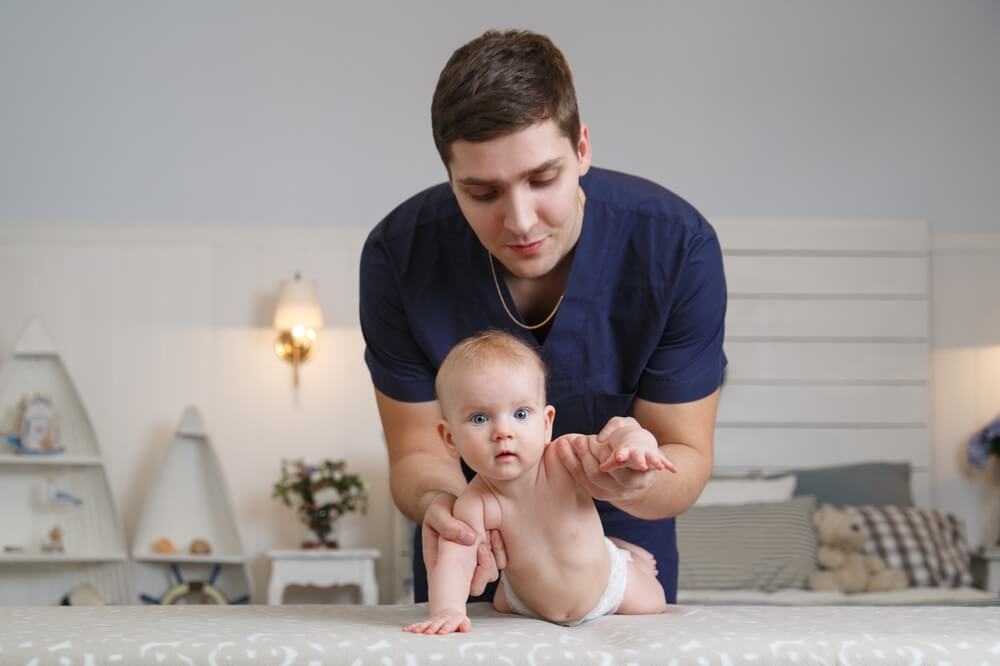
Pelevina Ksinia/Shutterstock.com
As stated, in most cases, there’s no need to worry if a baby isn’t crawling on time. However, if they’re not showing other signs of physical development—like rolling around or trying to lift themselves up—that may be a cause for concern. It may also be concerning if they seem behind in other developmental areas, like social interaction, speech, or fine motor skills.
So, if you notice these issues, or if you have any concerns that need addressing, it’s worthwhile to speak with your baby’s doctor for advice and reassurance.
Watch for the Next Developmental Milestones
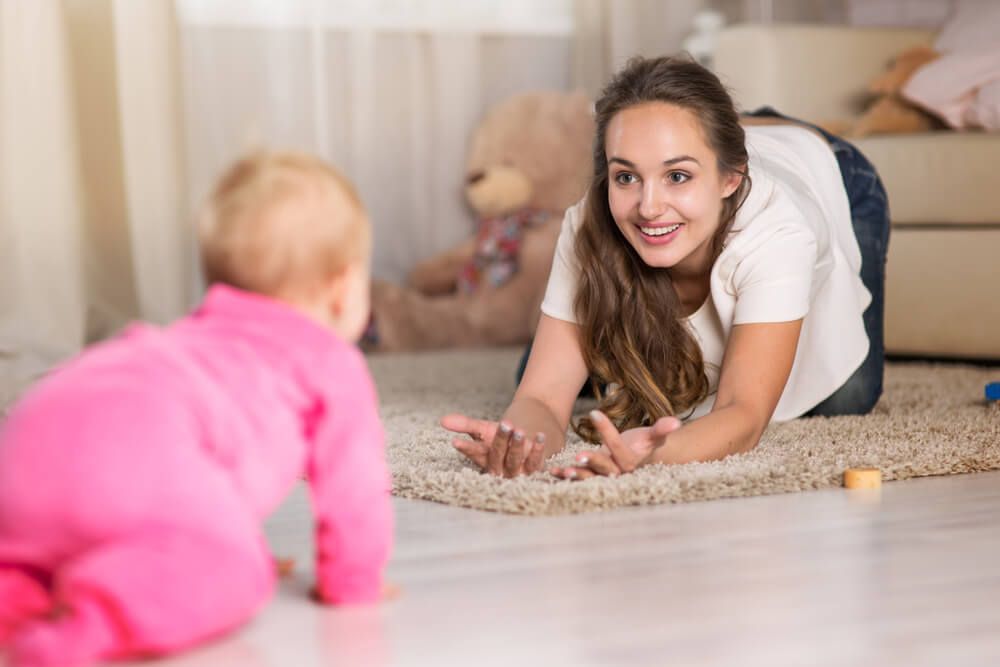
Tiplyashina Evgeniya/Shutterstock.com
While crawling isn’t considered an official milestone, as mentioned earlier, it’s still widely regarded as a key moment in a baby’s life. Once they’re able to crawl, some of the next big milestones and moments for parents to watch out for include.
Usually By 9 Months:
- Displays various facial expressions
- Looks for objects that are hidden from view
- Hits toys or other items together
- Makes sounds like “Mama”
- Lifts arms to be lifted up
- Looks when you call their name
- Smiles and laughs at peek-a-boo
Usually by 12 Months:
- Plays games like pat-a-cake
- Waves goodbye
- Calls parents “Mama” or “Dada” or a similar name
- Understands the word “No”
- Puts items (like toys) in containers
- Pulls themselves to stand
- Walks while holding onto furniture for support
- Drinks from a cup, held by a parent
Usually by 15 months:
- Copies other children while playing
- Claps when happy
- Hugs teddies or toys
- Shows affection
- Tries to say new words beyond “Mama” and “Dada”
- Points to ask for help or an item
- Takes a few steps on their own
The Crawling Milestone
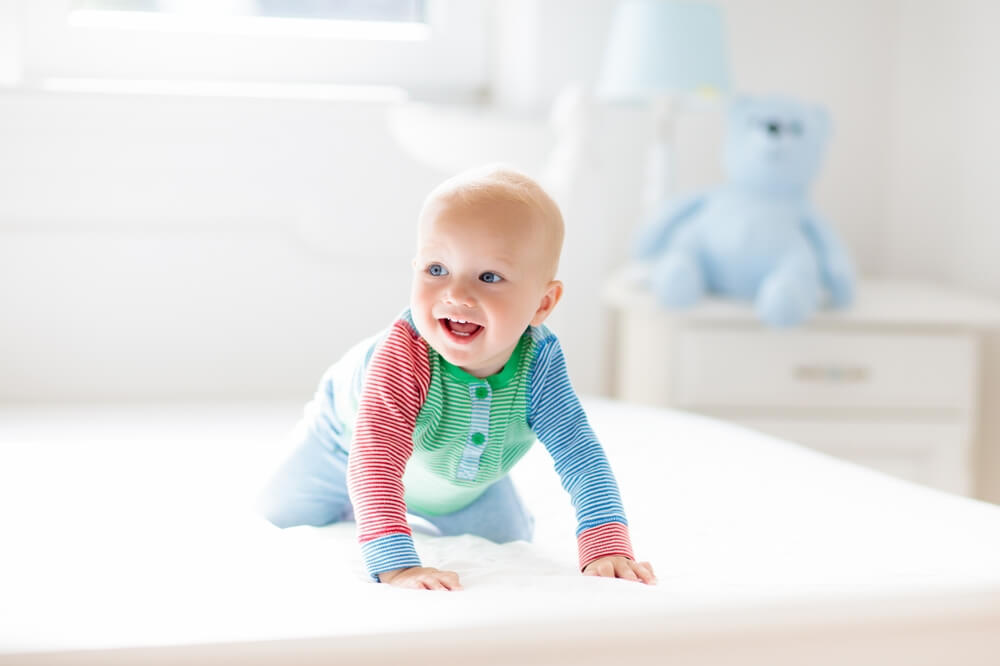
FamVeld/Shutterstock.com
So, there you have it. You can usually expect babies to start crawling anywhere from six to 12 months of age, with the average baby crawling by around nine months old. Some babies will pick up this skill faster than others, some will be a little slower to crawl.
Either way, parents shouldn’t stress or fret if their little ones aren’t crawling by the age of six or seven months, as it’s perfectly normal for babies to take a little longer than that. Some may even skip the crawling stage entirely and go straight to walking!
Be sure to share this guide around and let other moms and dads know what to watch for and how to support their little one’s development in the best possible ways.
FAQs

ANNA GRANT/Shutterstock.com
What Is the Earliest Baby To Crawl?
The earliest a baby will crawl is around five months. It’s highly unlikely for a baby to crawl any earlier than that, and many of them won’t start crawling until they’re around nine months old.
Can Babies Crawl at 4 Months?
It’s not impossible, but it’s unlikely. At four months, babies are not usually strong or developed enough, both physically and mentally, to be able to roll over, lift themselves up onto their hands and knees, and crawl along. Some may manage to crawl by five or six months, but this milestone usually comes a little later, around the nine-month mark.
Is Crawling at 6 Months Early?
Yes, six months is quite early for a crawling baby, but it’s not unheard of. Babies develop at different rates and in different ways. Some develop physically a lot faster than others, allowing them to start rolling over and crawling around as early as six months of age.
When Should a Baby Sit Up?
Typically, babies will be able to sit up with assistance by around six months and are usually sitting up on their own between nine and 12 months. But, as with other milestones, this may occur earlier or later in some children, as every baby is different.
The picture on the front page: DS Tkachuk/Shutterstock.com
Проверьте электронный ящик
















